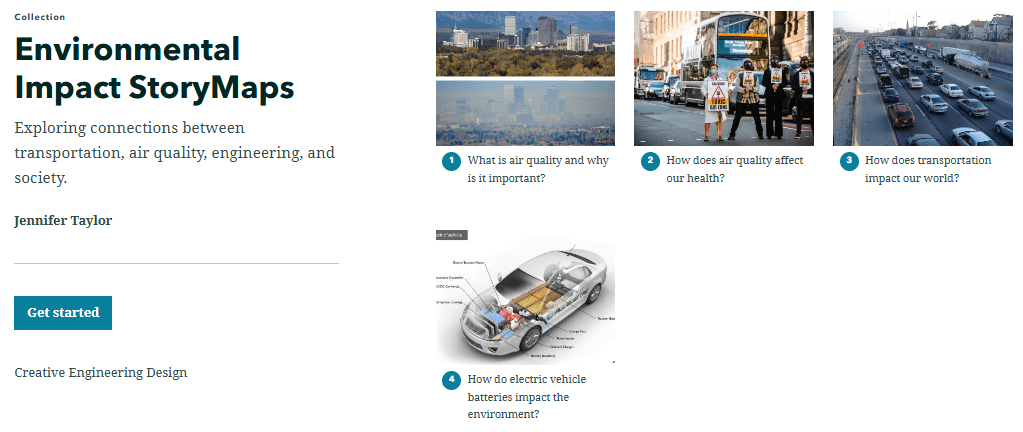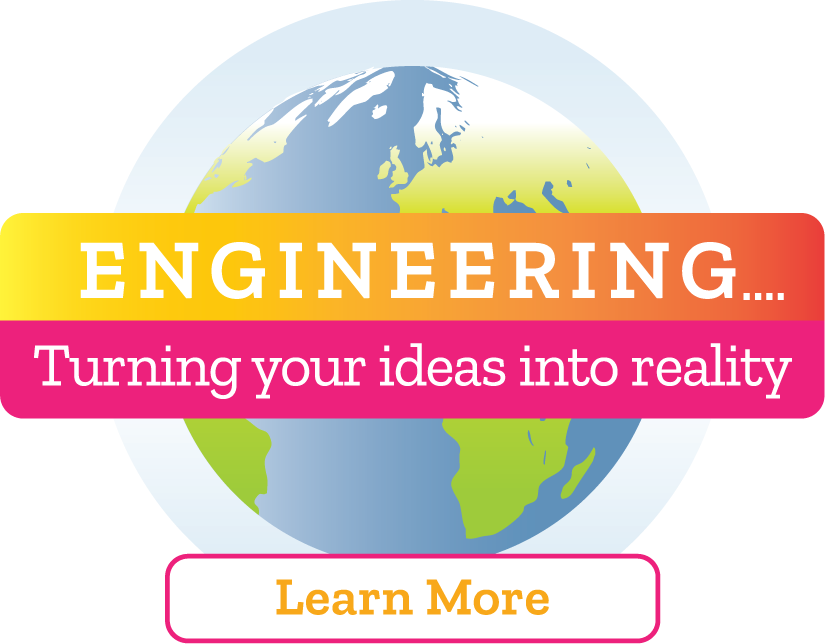Quick Look
Grade Level: 9 (9-12)
Time Required: 7 hours 30 minutes
(two 45-minute class periods or one 90-min block for each of the four Environmental Impact StoryMaps)
Expendable Cost/Group: US $0.00
Group Size: 2
Activity Dependency: None
Subject Areas: Earth and Space, Reasoning and Proof, Science and Technology
NGSS Performance Expectations:

| HS-ESS3-2 |
| HS-ESS3-4 |
| HS-ETS1-1 |
| HS-ETS1-3 |
| HS-LS2-7 |
| MS-ESS3-3 |
| MS-ESS3-4 |
| MS-ESS3-5 |
| MS-ETS1-1 |
| MS-ETS1-2 |

Summary
Ethics are an essential part of engineering. They guide engineers to ensure their designs and solutions prioritize safety, sustainability, and public well-being. The Environmental Impact StoryMap Collection actively engages students in exploring ethics-based, transportation-related topics. This StoryMap series was created using Esri ArcGIS technology to enable students to explore transportation and air quality relationships from sustainability- and community-based and engineering perspectives.Engineering Connection
Engineers must ensure that their work is done to the highest standards with honesty and integrity, as prescribed by the National Society of Professional Engineers (NSPE) Code of Ethics:
"Engineering has a direct and vital impact on the quality of life for all people. Accordingly, the services provided by engineers require honesty, impartiality, fairness, and equity, and must be dedicated to the protection of the public health, safety, and welfare. Engineers must perform under a standard of professional behavior that requires adherence to the highest principles of ethical conduct."
Geographic Information Systems (GIS) is an important tool for many professions, including engineering. GIS uses specialized software to collect, store, analyze, query, and visualize spatial data. It also supports users in applying critical thinking to solve problems and find solutions from a spatial perspective. GIS helps engineers seek answers to the questions related to “What’s there?” “Why is it there?” and “Why do we care?” to view engineering projects from the perspective of the people and communities they work with and serve.
Learning Objectives
After this activity, students should be able to:
- Understand the main relationships between sustainable transportation, air quality, the environment, and society
- Know the general sustainability impacts in local communities related to transportation and air quality issues
- Understand the role of ethics in engineering
- Navigate the online ArcGIS StoryMap tool
Educational Standards
Each TeachEngineering lesson or activity is correlated to one or more K-12 science,
technology, engineering or math (STEM) educational standards.
All 100,000+ K-12 STEM standards covered in TeachEngineering are collected, maintained and packaged by the Achievement Standards Network (ASN),
a project of D2L (www.achievementstandards.org).
In the ASN, standards are hierarchically structured: first by source; e.g., by state; within source by type; e.g., science or mathematics;
within type by subtype, then by grade, etc.
Each TeachEngineering lesson or activity is correlated to one or more K-12 science, technology, engineering or math (STEM) educational standards.
All 100,000+ K-12 STEM standards covered in TeachEngineering are collected, maintained and packaged by the Achievement Standards Network (ASN), a project of D2L (www.achievementstandards.org).
In the ASN, standards are hierarchically structured: first by source; e.g., by state; within source by type; e.g., science or mathematics; within type by subtype, then by grade, etc.
NGSS: Next Generation Science Standards - Science
| NGSS Performance Expectation | ||
|---|---|---|
|
HS-ESS3-2. Evaluate competing design solutions for developing, managing, and utilizing energy and mineral resources based on cost-benefit ratios. (Grades 9 - 12) Do you agree with this alignment? |
||
| Click to view other curriculum aligned to this Performance Expectation | ||
| This activity focuses on the following Three Dimensional Learning aspects of NGSS: | ||
| Science & Engineering Practices | Disciplinary Core Ideas | Crosscutting Concepts |
| Evaluate competing design solutions to a real-world problem based on scientific ideas and principles, empirical evidence, and logical arguments regarding relevant factors (e.g. economic, societal, environmental, ethical considerations). Alignment agreement: | All forms of energy production and other resource extraction have associated economic, social, environmental, and geopolitical costs and risks as well as benefits. New technologies and social regulations can change the balance of these factors. Alignment agreement: When evaluating solutions it is important to take into account a range of constraints including cost, safety, reliability and aesthetics and to consider social, cultural and environmental impacts.Alignment agreement: | Science and technology may raise ethical issues for which science, by itself, does not provide answers and solutions. Alignment agreement: Science knowledge indicates what can happen in natural systems—not what should happen. The latter involves ethics, values, and human decisions about the use of knowledge.Alignment agreement: Many decisions are not made using science alone, but rely on social and cultural contexts to resolve issues.Alignment agreement: |
| NGSS Performance Expectation | ||
|---|---|---|
|
HS-ESS3-4. Evaluate or refine a technological solution that reduces impacts of human activities on natural systems. (Grades 9 - 12) Do you agree with this alignment? |
||
| Click to view other curriculum aligned to this Performance Expectation | ||
| This activity focuses on the following Three Dimensional Learning aspects of NGSS: | ||
| Science & Engineering Practices | Disciplinary Core Ideas | Crosscutting Concepts |
| Design or refine a solution to a complex real-world problem, based on scientific knowledge, student-generated sources of evidence, prioritized criteria, and tradeoff considerations. Alignment agreement: | Scientists and engineers can make major contributions by developing technologies that produce less pollution and waste and that preclude ecosystem degradation. Alignment agreement: When evaluating solutions it is important to take into account a range of constraints including cost, safety, reliability and aesthetics and to consider social, cultural and environmental impacts.Alignment agreement: | Feedback (negative or positive) can stabilize or destabilize a system. Alignment agreement: Engineers continuously modify these technological systems by applying scientific knowledge and engineering design practices to increase benefits while decreasing costs and risks.Alignment agreement: |
| NGSS Performance Expectation | ||
|---|---|---|
|
HS-ETS1-1. Analyze a major global challenge to specify qualitative and quantitative criteria and constraints for solutions that account for societal needs and wants. (Grades 9 - 12) Do you agree with this alignment? |
||
| Click to view other curriculum aligned to this Performance Expectation | ||
| This activity focuses on the following Three Dimensional Learning aspects of NGSS: | ||
| Science & Engineering Practices | Disciplinary Core Ideas | Crosscutting Concepts |
| Analyze complex real-world problems by specifying criteria and constraints for successful solutions. Alignment agreement: | Criteria and constraints also include satisfying any requirements set by society, such as taking issues of risk mitigation into account, and they should be quantified to the extent possible and stated in such a way that one can tell if a given design meets them. Alignment agreement: Humanity faces major global challenges today, such as the need for supplies of clean water and food or for energy sources that minimize pollution, which can be addressed through engineering. These global challenges also may have manifestations in local communities.Alignment agreement: | New technologies can have deep impacts on society and the environment, including some that were not anticipated. Analysis of costs and benefits is a critical aspect of decisions about technology. Alignment agreement: |
| NGSS Performance Expectation | ||
|---|---|---|
|
HS-ETS1-3. Evaluate a solution to a complex real-world problem based on prioritized criteria and trade-offs that account for a range of constraints, including cost, safety, reliability, and aesthetics, as well as possible social, cultural, and environmental impacts. (Grades 9 - 12) Do you agree with this alignment? |
||
| Click to view other curriculum aligned to this Performance Expectation | ||
| This activity focuses on the following Three Dimensional Learning aspects of NGSS: | ||
| Science & Engineering Practices | Disciplinary Core Ideas | Crosscutting Concepts |
| Evaluate a solution to a complex real-world problem, based on scientific knowledge, student-generated sources of evidence, prioritized criteria, and tradeoff considerations. Alignment agreement: | When evaluating solutions it is important to take into account a range of constraints including cost, safety, reliability and aesthetics and to consider social, cultural and environmental impacts. Alignment agreement: | New technologies can have deep impacts on society and the environment, including some that were not anticipated. Analysis of costs and benefits is a critical aspect of decisions about technology. Alignment agreement: |
| NGSS Performance Expectation | ||
|---|---|---|
|
HS-LS2-7. Design, evaluate, and refine a solution for reducing the impacts of human activities on the environment and biodiversity. (Grades 9 - 12) Do you agree with this alignment? |
||
| Click to view other curriculum aligned to this Performance Expectation | ||
| This activity focuses on the following Three Dimensional Learning aspects of NGSS: | ||
| Science & Engineering Practices | Disciplinary Core Ideas | Crosscutting Concepts |
| Design, evaluate, and refine a solution to a complex real-world problem, based on scientific knowledge, student-generated sources of evidence, prioritized criteria, and tradeoff considerations. Alignment agreement: | Moreover, anthropogenic changes (induced by human activity) in the environment—including habitat destruction, pollution, introduction of invasive species, overexploitation, and climate change—can disrupt an ecosystem and threaten the survival of some species. Alignment agreement: Biodiversity is increased by the formation of new species (speciation) and decreased by the loss of species (extinction).Alignment agreement: Humans depend on the living world for the resources and other benefits provided by biodiversity. But human activity is also having adverse impacts on biodiversity through overpopulation, overexploitation, habitat destruction, pollution, introduction of invasive species, and climate change. Thus sustaining biodiversity so that ecosystem functioning and productivity are maintained is essential to supporting and enhancing life on Earth. Sustaining biodiversity also aids humanity by preserving landscapes of recreational or inspirational value.Alignment agreement: When evaluating solutions it is important to take into account a range of constraints including cost, safety, reliability and aesthetics and to consider social, cultural and environmental impacts.Alignment agreement: | Much of science deals with constructing explanations of how things change and how they remain stable. Alignment agreement: |
| NGSS Performance Expectation | ||
|---|---|---|
|
MS-ESS3-3. Apply scientific principles to design a method for monitoring and minimizing a human impact on the environment. (Grades 6 - 8) Do you agree with this alignment? |
||
| Click to view other curriculum aligned to this Performance Expectation | ||
| This activity focuses on the following Three Dimensional Learning aspects of NGSS: | ||
| Science & Engineering Practices | Disciplinary Core Ideas | Crosscutting Concepts |
| Apply scientific principles to design an object, tool, process or system. Alignment agreement: | Human activities have significantly altered the biosphere, sometimes damaging or destroying natural habitats and causing the extinction of other species. But changes to Earth's environments can have different impacts (negative and positive) for different living things. Alignment agreement: | Relationships can be classified as causal or correlational, and correlation does not necessarily imply causation. Alignment agreement: The uses of technologies and any limitations on their use are driven by individual or societal needs, desires, and values; by the findings of scientific research; and by differences in such factors as climate, natural resources, and economic conditions. Thus technology use varies from region to region and over time.Alignment agreement: |
| NGSS Performance Expectation | ||
|---|---|---|
|
MS-ESS3-4. Construct an argument supported by evidence for how increases in human population and per-capita consumption of natural resources impact Earth's systems. (Grades 6 - 8) Do you agree with this alignment? |
||
| Click to view other curriculum aligned to this Performance Expectation | ||
| This activity focuses on the following Three Dimensional Learning aspects of NGSS: | ||
| Science & Engineering Practices | Disciplinary Core Ideas | Crosscutting Concepts |
| Construct an oral and written argument supported by empirical evidence and scientific reasoning to support or refute an explanation or a model for a phenomenon or a solution to a problem. Alignment agreement: | Typically as human populations and per-capita consumption of natural resources increase, so do the negative impacts on Earth unless the activities and technologies involved are engineered otherwise. Alignment agreement: | Cause and effect relationships may be used to predict phenomena in natural or designed systems. Alignment agreement: All human activity draws on natural resources and has both short and long-term consequences, positive as well as negative, for the health of people and the natural environment.Alignment agreement: Scientific knowledge can describe the consequences of actions but does not necessarily prescribe the decisions that society takes.Alignment agreement: |
| NGSS Performance Expectation | ||
|---|---|---|
|
MS-ESS3-5. Ask questions to clarify evidence of the factors that have caused the rise in global temperatures over the past century. (Grades 6 - 8) Do you agree with this alignment? |
||
| Click to view other curriculum aligned to this Performance Expectation | ||
| This activity focuses on the following Three Dimensional Learning aspects of NGSS: | ||
| Science & Engineering Practices | Disciplinary Core Ideas | Crosscutting Concepts |
| Ask questions to identify and clarify evidence of an argument. Alignment agreement: | Human activities, such as the release of greenhouse gases from burning fossil fuels, are major factors in the current rise in Earth's mean surface temperature (global warming). Reducing the level of climate change and reducing human vulnerability to whatever climate changes do occur depend on the understanding of climate science, engineering capabilities, and other kinds of knowledge, such as understanding of human behavior and on applying that knowledge wisely in decisions and activities. Alignment agreement: | Stability might be disturbed either by sudden events or gradual changes that accumulate over time. Alignment agreement: |
| NGSS Performance Expectation | ||
|---|---|---|
|
MS-ETS1-1. Define the criteria and constraints of a design problem with sufficient precision to ensure a successful solution, taking into account relevant scientific principles and potential impacts on people and the natural environment that may limit possible solutions. (Grades 6 - 8) Do you agree with this alignment? |
||
| Click to view other curriculum aligned to this Performance Expectation | ||
| This activity focuses on the following Three Dimensional Learning aspects of NGSS: | ||
| Science & Engineering Practices | Disciplinary Core Ideas | Crosscutting Concepts |
| Define a design problem that can be solved through the development of an object, tool, process or system and includes multiple criteria and constraints, including scientific knowledge that may limit possible solutions. Alignment agreement: | The more precisely a design task's criteria and constraints can be defined, the more likely it is that the designed solution will be successful. Specification of constraints includes consideration of scientific principles and other relevant knowledge that is likely to limit possible solutions. Alignment agreement: | All human activity draws on natural resources and has both short and long-term consequences, positive as well as negative, for the health of people and the natural environment. Alignment agreement: The uses of technologies and any limitations on their use are driven by individual or societal needs, desires, and values; by the findings of scientific research; and by differences in such factors as climate, natural resources, and economic conditions.Alignment agreement: |
| NGSS Performance Expectation | ||
|---|---|---|
|
MS-ETS1-2. Evaluate competing design solutions using a systematic process to determine how well they meet the criteria and constraints of the problem. (Grades 6 - 8) Do you agree with this alignment? |
||
| Click to view other curriculum aligned to this Performance Expectation | ||
| This activity focuses on the following Three Dimensional Learning aspects of NGSS: | ||
| Science & Engineering Practices | Disciplinary Core Ideas | Crosscutting Concepts |
| Evaluate competing design solutions based on jointly developed and agreed-upon design criteria. Alignment agreement: | There are systematic processes for evaluating solutions with respect to how well they meet the criteria and constraints of a problem. Alignment agreement: | |
Materials List
Each student or team of two needs:
- 1 laptop/computer with internet connection: Windows, Mac, or Chrome OS recommended (but not needed)
- Access to https://storymaps.arcgis.com/collections/d56e2cb1243944e996fea875c0d14810
For the entire class to share:
- 1 laptop computer with access to the internet
- projector
Worksheets and Attachments
Visit [www.teachengineering.org/activities/view/cub-2812-environmental-impact-storymap-collection-activity] to print or download.Introduction/Motivation
Why are ethics an essential part of engineering? Ethical engineering means engineers should engage with all stakeholders and assess the value and impacts of engineering projects from the perspective of and with input from the communities they serve.
You will explore the Environmental Impact StoryMap Collection to build your knowledge about how engineering relates to sustainable transportation from the perspectives of air quality, public health, and the environment in your local community and around the country.
Procedure
Background
The Environmental Impact StoryMap Collection is a web-based storytelling tool that integrates concise text, academic vocabulary, images, infographics, video, and interactive geospatial maps to support the learning and applying STEM and engineering-related content from a sustainability perspective.
The framework for each of the four Environmental Impact StoryMaps includes the following sections:
- Essential Question (title)
- Introduction – Think About It
- Content Knowledge Building
- Geospatial Data Explorations
- Engineering Connection
- Discussion – Talk About It
Based on teacher feedback, it is suggested that the first StoryMap be teacher-led, ideally using a SmartBoard or similar computer screen projection, via a whole class learning experience to support students in learning how to use and engage in the StoryMap format (this may take two class periods in the first instance).
Once students are familiar with using the StoryMap format, options to adapt the StoryMap activity include assigning the StoryMap as a homework assignment followed by an in-depth discussion or supplementary activity that further explores content presented in the StoryMap, etc.
Before the Activity
- Teachers should review the Environmental Impact StoryMap Collection to become familiar with its content and format.
- Teachers should set up the specific online StoryMap and projector before class.
- Share the digital worksheet for the specific StoryMap (or print hard copies) with students.
Environmental Impact StoryMap Collection:
- Read through the Introduction/Motivation section.
- Display the specific StoryMap from the Environmental Impact StoryMap Collection.
Environmental Impact StoryMap #1: What is air quality and why is it important?
Learn about particulate matter (PM) pollution, the sources of PM, and how PM air pollution is measured.
Students will explore multi-media learning blocks to build their background knowledge about particulate matter (PM) air pollution and interact with the AirNow.gov Air Quality Aware geospatial map to explore air quality and related transportation concepts in the community where they live and go to school.

Environmental Impact StoryMap #2: How does air quality affect our health?
Dive into how air pollution affects public health, who is at risk, and actions to take on air quality advisory days.
Students will explore multi-media learning blocks to build their background knowledge about air pollution and its health impacts and interact with the AirNow.gov Air Quality Aware geospatial map to explore air quality and related transportation concepts in the community where they live and go to school.

Environmental Impact StoryMap #3: How does transportation impact our world?
Learn about cars and carbon emissions through the impacts of traditional gas-burning vehicles and newer electric vehicle technology on the environment, the relationships between greenhouse gases and transportation, and analyzing transportation options and solutions.
Students will explore multi-media learning blocks to build their background knowledge about cars and carbon emissions and, interact with the AirNow.gov Air Quality Aware geospatial map to explore air quality and transportation concepts in the community where they live and go to school.

Environmental Impact StoryMap #4: How do electric vehicle batteries impact the environment?
Build your understanding of battery basics and lithium-ion batteries that power electric vehicles (EVs). Learn about the sources and environmental impacts of lithium used to power electronics, such as cell phones, computers, and Eversion, and explore solutions to advance a more sustainable battery-powered future.
Students will explore multi-media learning blocks to build their background knowledge about lithium-ion battery structure, supply and demand for lithium, the challenges of meeting community needs, and sustainability issues related to clean energy transportation. Students then watch a series of case studies about lithium deposit locations and mining, as noted on a US geospatial map, to understand the challenges of sourcing lithium and balancing it with community and environmental needs.

Vocabulary/Definitions
air quality: A rating of how clean, or dirty, the air is that we breathe.
air quality index (AQI): A scale that describes how healthy or unhealthy the air currently is and what it's forecasted to be over the next few days.
particulate matter (PM): A mixture of very small solid particles and liquid droplets that are emitted into the air and transported by air.
Assessment
Activity Embedded (Formative) Assessment
Students complete the Check for Understanding Worksheets for each of the four Environmental Impact StoryMaps.
Post-Activity (Summative) Assessment
Students participate in a class discussion on the Check for Understanding worksheet questions to reflect on the content explored and ideas on how engineering can help find solutions to the sustainability issues investigated.
Subscribe
Get the inside scoop on all things TeachEngineering such as new site features, curriculum updates, video releases, and more by signing up for our newsletter!Copyright
© 2023 by Regents of the University of ColoradoContributors
Jennifer TaylorSupporting Program
Integrated Teaching and Learning Program, College of Engineering, University of Colorado BoulderAcknowledgements
This curriculum was developed under National Science Foundation grant numbers 1941524 and 1941701. Any opinions, findings, and conclusions, or recommendations expressed in this material are those of the authors and do not necessarily reflect the views of the National Science Foundation.
Last modified: March 31, 2025






User Comments & Tips